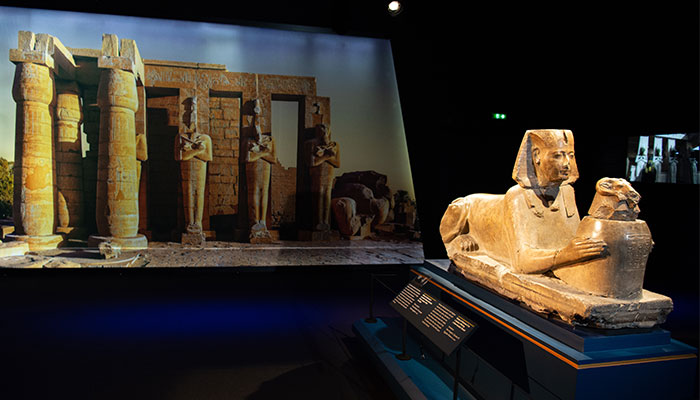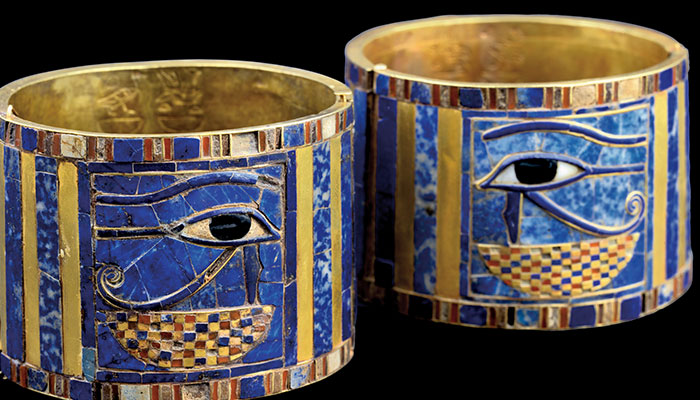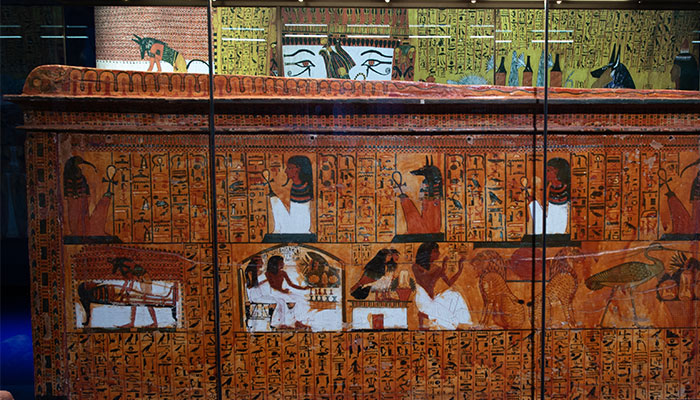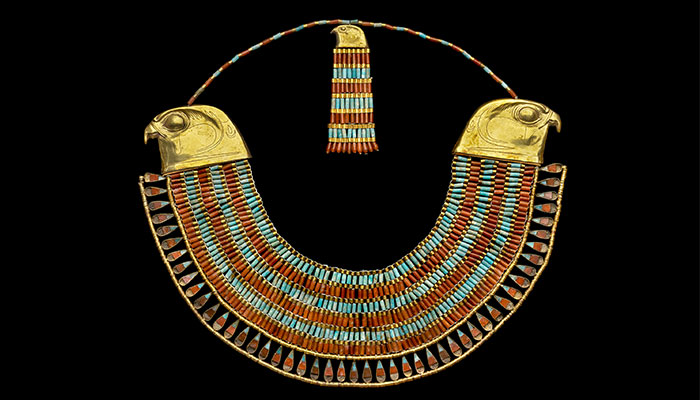What was Egypt like 3,300 years ago? You had to be there! And thanks to a new blockbuster exhibition at the Australian Museum, you can be.

Ramses and the Gold of the Pharaohs: Statue of Ramses kneeling. Image: World Heritage Exhibitions
Ramses & The Gold of the Pharaohs is a voyage around ancient Egypt in the time of one of its most celebrated pharaohs, Ramses the Great, who reigned from 1279-1213 BCE, the Third Ruler of the 19th Dynasty.
A military leader, warrior, and diplomat, Ramses II ruled for nearly 67 years, living to about 92. He expanded national borders, brokered history’s first known peace treaty, and spearheaded the building of cities, temples and monuments – often repurposing others’ memorials with his own name! He had several royal wives and dozens of concubines and sired more children than possibly any other pharaoh (well over 100).
He’s the kind of pharaoh who would have been pleased to have an exhibition named after him. He was obsessed with his legacy.
At the Australian Museum, the story of Ramses the Great is a multi-sensory immersion that marries history with 21st-century technology. Hear spears clash, arrows zip, lions leap, chariots thunder; imagine the sting of sandstorms and experience the cut and thrust of the 1274 BCE Battle of Kadesh.
Computer-generated imagery, video, high-definition projection, surround sound, mood lighting and special effects underpin this exhibition. Even CT scans are in on the act, used to reveal amulets hidden in mummies.
VR trip into the Valley of the Queens
A virtual reality option takes the viewer, in cinematic motion chairs, into two of Ramses’s most incomparable monuments: the rock-cut Abu Simbel temples in Nubia and the highly decorated tomb of his beloved Royal Consort, Queen Nefertari, in the Valley of the Queens.

Ramses and the Gold of the Pharaohs: bracelets of Sheshonq 11 with Wedja Eye Intermediate Period 22nd Dynasty. Image: World Heritage Exhibitions
The exhibition will change the way we perceive ancient Egypt, says Dr Camilla Di Biase-Dyson, senior lecturer in Egyptology in Macquarie University’s Department of History and Archaeology.
“People from all walks of life will get an almost visceral sense of what life was like in antiquity. To be able to enter the most beautiful monuments in Egypt – without having to buy a plane ticket – will alter perceptions.
“The objects, too, are life changing. Once you’ve seen that level of handiwork, you appreciate what people from those times were able to do.”
The star attraction of the $2.5 billion (US$1.6 billion) exhibition is the coffin of Ramses II, a loan that rewards a long-standing working relationship between the Australian Museum’s CEO, Kim McKay AO, and Dr Zahi Hawass (former head of Egypt’s Supreme Council of Antiquities), the curator of Ramses & the Gold of the Pharaohs along with exhibition partners, Neon Global and World Heritage Exhibitions. (Macquarie University is the program partner, see below.)
Made from highest-quality cedar, the coffin is believed to have been repurposed (a common practice) from one made during the previous Dynasty. It was once gilded and possibly inlaid with precious stones. The King is represented as the god Osiris. Arms crossed on his chest, he holds two royal sceptres and wears the nemes headdress (a striped headcloth worn by the rulers of Egypt), decorated with an erect cobra and a false beard braided beneath his chin.

Ramses and the Gold of the Pharaohs: outer coffin of Sennedjen, with lid, on a wooden sledge. Image: World Heritage Exhibitions
Its wonder, says Dr Di Biase-Dyson, lies not just in its spectacle and beauty but in the myriad stories it tells about both criminal and state-sanctioned tomb-robbing, burial customs, the role of high priests and scribes, living and working conditions, the trade of precious materials and the economics of state.
Of special interest to Dr Di Biase-Dyson are objects from the tomb of Sennedjem, a talented artist living at Deir el-Medina, a village of artisans who built and decorated the royal tombs in the Valley of the Kings. Sennedjem’s coffin is beautifully finished with texts and vignettes from the Book of the Dead, executed in vivid black, blue, and red on a yellow background.
Among the 180-odd artefacts on display in Ramses & the Gold of the Pharaohs are golden masks, amulets and jewellery, including a solid gold collar crafted more than 3000 years ago and weighing 4.3kg. There are animal mummies including cats, crocodiles, a mongoose, and a lion cub.

Ramses and the Gold of the Pharaohs: collar of Princess Neferuptah. Image: World Heritage Exhibitions.
To underscore the magnificence of Egyptian civilisation, many beautiful treasures from the Middle Kingdom (2030-1650 BCE) – diadems, necklaces, bracelets, anklets, girdles and pectorals – are included in this exhibition, as are some of the precious treasures, jewellery and coffins unearthed in 1939 during an excavation of the ancient city of Tanis, a seat of royal government in Dynasties 21 and 22.
According to Fran Dorey, the Australian Museum’s Head of Exhibitions, “Logistically, it’s been the biggest production we’ve ever had to do. An exhibition on steroids.”
The heaviest exhibition piece, she says, weighs nearly two tonnes; the limestone colossus head of Ramses II that welcomes museumgoers weighs more than 1700kg.
Dr Di Biase-Dyson has no doubt that Ramses the Great, played by Yul Brynner in the 1956 film The Ten Commandments, would have approved of Ramses & the Gold of the Pharaohs.
“He’s the kind of pharaoh who would have been pleased to have an exhibition named after him. He was obsessed with his legacy,” she says.
In partnership with Macquarie expertise
Macquarie University is the program partner of Ramses & the Gold of the Pharaohs, which runs from November 18 to May 19, 2024. Ronika Power, Professor of Bioarchaeology, and Dr Georgia Barker, Early Career Researcher, both from the Department of History and Archaeology, have co-curated a four-series public program, comprising Breakfast Behind the Scenes, Saturday Lecture Series, and Tomb Talks, mostly led by Macquarie University experts.
A keynote public lecture series starts on Saturday, 25 November, with Professor Malcolm Choat, Head of the Department of History and Archaeology, talking about the afterlife of the tomb of Ramses II. For further details and tickets, see australian.museum/event/gateway-to-egypt-programs/
Dr Camilla Di Biase-Dyson is a senior lecturer in the Macquarie University Department of History and Archaeology.







